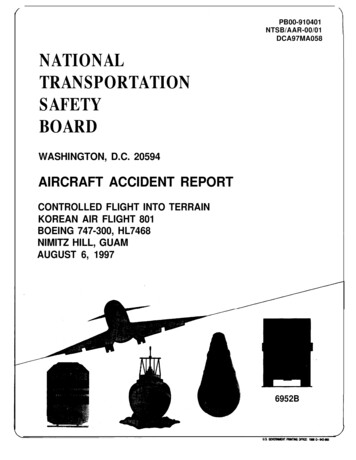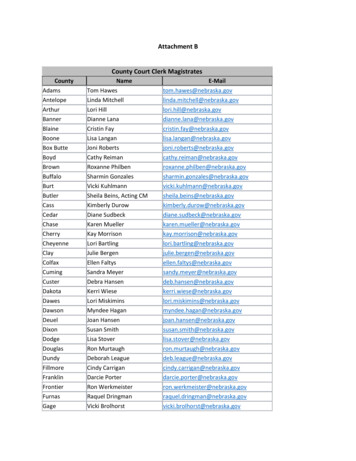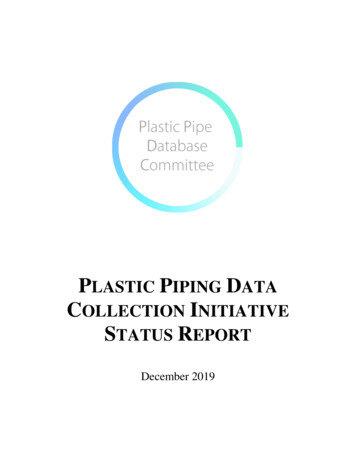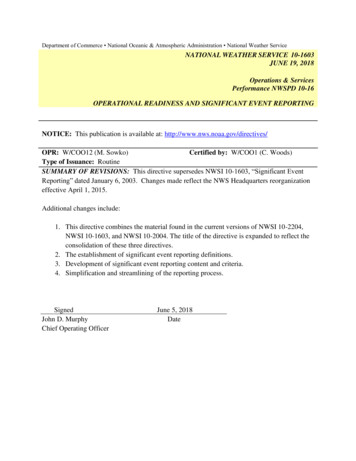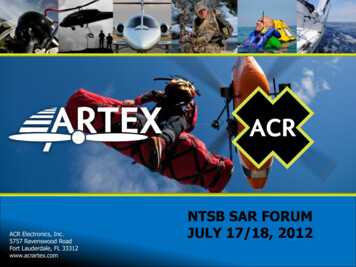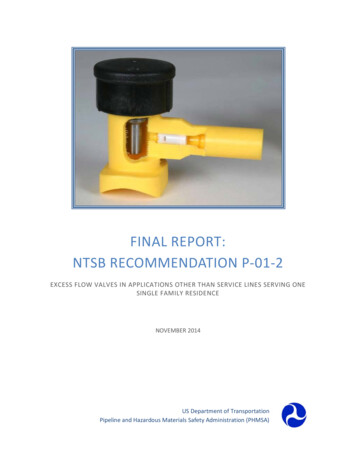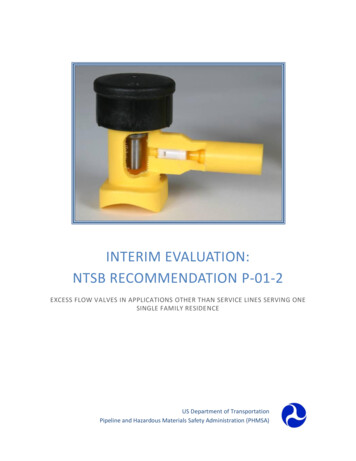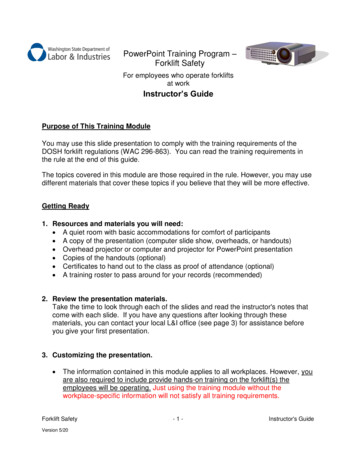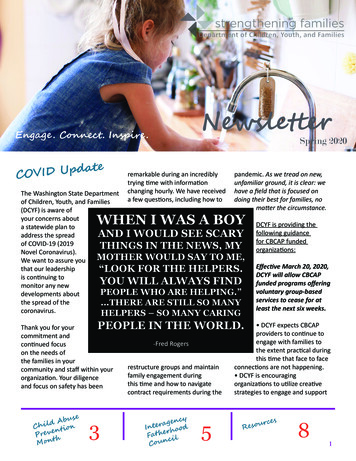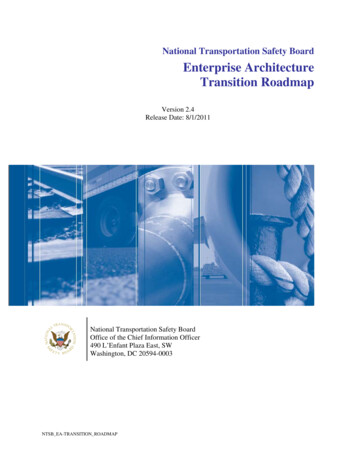
Transcription
National Transportation Safety BoardEnterprise ArchitectureTransition RoadmapVersion 2.4Release Date: 8/1/2011National Transportation Safety BoardOffice of the Chief Information Officer490 L’Enfant Plaza East, SWWashington, DC 20594-0003NTSB EA-TRANSITION ROADMAP
-i-Enterprise ArchitectureTransition RoadmapRecord of ChangesModifications to this document since the issuance are as follows:Version2.42.32.22.12.01.11.0Record of ChangesDescription of ChangeDateUpdated initiatives and projects8/1/2011Updated to reflect Open GovernmentInitiative (Data.gov), NTSBorganization changes and changes8/23/2010concerning the EA assessmentframeworkUpdated transition sequencing plan12/23/2009Finalized version 2.1 for posting9/26/2008Version 2.0 finalized6/30/2008Initial Draft for Version 2.0 of theRoadmap; Reinstated Sections 5 and 66/17/2008which were removed for Version 1.0Finalized version for delivery5/13/2008NTSB EA-TRANSITION ROADMAPNameEv TottenEv TottenEv TottenEv TottenEv TottenBill DanaBill Dana
- ii -Enterprise ArchitectureTransition RoadmapTable of ContentsRecord of Changes . iTable of Contents . iiList of Figures . 4List of Tables . 4Message from the Chief Enterprise Architect, Ev Totten . 51.01.11.21.31.42.0Introduction. 1Background . 1Purpose. 2Audience . 2Document Organization . 2Enterprise Architecture 101 – An Introduction . 42.1What Is the Federal Enterprise Architecture? . 42.2What Is Enterprise Architecture? . 52.3Why Does NTSB Need an Enterprise Architecture Program? . 62.3.1What are the potential benefits from Enterprise Architecture? . 72.3.2Why do we need a Methodology for Business Transformation (MBT)? . 73.0NTSB’s Enterprise Architecture Program . 93.1Enterprise Architecture’s Mission, Vision, and Goal . 93.1.1Mission. 93.1.2Vision . 93.1.3Goal . 103.2Enterprise Architecture Performance Life Cycle Framework . 103.2.1Activities of the Performance Life Cycle Framework for IT . 123.3Enterprise Architecture Program Roadmap . 143.4Business Drivers for the Enterprise Architecture Program. 183.5Enterprise Architecture Program Integration with other NTSB Processes . 223.5.1Standards Integration . 223.5.2Configuration Management Process . 233.5.3Information System Development Life Cycle . 233.5.4Investment/Capital Planning . 233.5.5Enterprise Architecture Development. 233.5.6IT Acquisitions. 243.5.7Information Security . 243.5.8IT Performance Measurement & Management. 243.5.9Strategic Planning . 244.04.14.24.3Transition Planning . 25Approach . 25Methodology . 25Enterprise Architecture Assessment Framework . 26NTSB EA-TRANSITION ROADMAP
-34.3.15.0Enterprise ArchitectureTransition RoadmapAssessed Maturity Level . 27Transition Strategy. 325.1Define Initiatives, Projects, and Programs . 325.1.1Transition Initiative Description . 335.1.2Transition Project Description . 335.1.3Transition Program Description. 345.2Transition Initiatives . 355.2.1Enterprise Architecture Program Framework and Governance . 355.2.2Enterprise Architecture Transition Roadmap . 355.2.3IT Capital Planning and Investment Control (CPIC). 355.2.4Configuration Management Program/Process . 355.2.5Information System Development Life Cycle Model (ISDLC) . 355.2.6FEA Business Reference Model Development. 365.2.7Business Process Flow Documentation . 425.2.8IT Security Trust Model (System Interconnections) . 435.2.9“As-Is” Architecture Design . 435.2.10“Target State Vision” Architecture Design. 435.2.11Standards Integration . 435.3Transition Projects . 445.3.1Internet Protocol Version 6 (IPV6) . 445.3.2Federal Desktop Core Configuration (FDCC) . 445.3.3Trusted Internet Connections (TIC) . 445.3.4Domain Name System Security (DNSSEC) . 455.3.5Open Government/Data.gov . 455.4Transition Programs . 456.0Transition Sequencing Plan . 466.1Transition Prioritization / Dependencies . 466.2Transition Start/End Dates . 476.3Transition Milestones. 496.3.1Business Process Flow Documentation Transition Milestones . 547.0Review of Prior Fiscal Year Accomplishments. 57Appendix A – Acronyms . 58Appendix B – Glossary . 61Appendix C – NTSB Enterprise Architecture Governance . 70NTSB EA-TRANSITION ROADMAP
-4-Enterprise ArchitectureTransition RoadmapList of FiguresFigure 2.3-2, Example of a Methodology for Business Transformation (MBT) Process. 8Figure 3.1, Enterprise Architecture’s Mission, Vision, and Goals . 9Figure 3.2-1, Performance Life Cycle Framework . 10Figure 3.2-2, Activities within the Performance Life Cycle Framework . 11Figure 3.2-3, Performance Life Cycle Framework applied to an Individual IT System . 12Figure 3.3-1, NTSB Enterprise Architecture Roadmap . 16Figure 3.3-2, NTSB Enterprise Architecture Annual Program and Reporting Life Cycle . 17Figure 3.5, Participation in Enterprise Architecture and Related Processes. 22Figure 4.3, Enterprise Architecture Assessment Framework Maturity Levels . 26Figure 4.3-1, NTSB’s Enterprise Architecture Self Assessed Maturity Level – FY 2008 . 31Figure 5.0-1, NTSB’s Enterprise Architecture Transition Strategy: from Baseline to Target . 32Figure 5.1-1, Initiatives, Projects, and Programs Relationship. 33Figure 5.2.6.1-1, Federal Business Reference Model Components. 37Figure 5.2.6.1-2, NTSB Business Reference Model Components . 38Figure 5.2.6.1-3, FEA Business Areas and Lines of Business’s aligned to NTSB’s Activities . 39Figure 5.2.6.3-1, FEA Service Component Reference Model Domains and Service Types . 40Figure 5.2.6.4-1, FEA Technical Reference Model Service Areas/Components . 41List of TablesTable 4.3.1-1, Enterprise Architecture Completion Capability Maturity Level . 28Table 4.3.1-2, Enterprise Architecture Use Capability Maturity Level. 29Table 4.3.1-3, Enterprise Architecture Results Capability Maturity Level . 30Table 5.2.6, Business Process Flow Documentation . 42Table 6.1, Transition Prioritization / Dependencies . 47Table 6.2, Transition Start/End Dates . 48Table 6.3, Transition Milestones . 54Table 6.3.1, Business Process Flow Documentation Transition Milestones . 56Table 7.0, Review of Prior Fiscal Year Accomplishments. 57NTSB EA-TRANSITION ROADMAP
-5-Enterprise ArchitectureTransition RoadmapMessage from the Chief Enterprise Architect, Ev TottenThe release of this Enterprise Architecture Transition Roadmap marks one of the first majormilestones in the establishment of the National Transportation Safety Board’s (NTSB) EnterpriseArchitecture Program. The Office of the Chief Information Officer began the initiative toestablish an Enterprise Architecture Program during the last half of Fiscal Year (FY) 2007. Ijoined the National Transportation Safety Board midway through the first quarter of FY 2008 toserve as the first Chief Enterprise Architect and implement the vision for the EnterpriseArchitecture Program established in the Information Technology Strategic Plan FY 2007 – FY2012 by the Chief Information Officer, Bob Scherer.I am new to the NTSB, and the concept of an Enterprise Architecture is new to the NTSB.Therefore, it is important to publish a Transition Roadmap immediately to: introduce the Enterprise Architecture Program to you; meet and get to know my new coworkers; and learn more about our mission/internal operations/administrative tasks (both thosesupported by Information Systems and those not supported by Information Systems).This document is primarily focused on the efforts I intend to accomplish this year in order toestablish the Enterprise Architecture Program. It is important that you understand the purpose ofthe program, how you can leverage the program, as well as how you can influence andparticipate in the development of the future of the Enterprise Architecture.To that end, this Transition Roadmap is focused on education and information rather thanserving as a technical treatise. Hence, I am providing within the roadmap a brief, non-technicaldescription about the initiatives I will be working to complete within my first year as ChiefEnterprise Architect. You may notice, as you read this document, that many of the processes arenot new. They are revisions to existing processes, a formalization of a current informal orundocumented process, or a combination of similar processes into an integrated andcomprehensive process.This document will be updated over time and will undoubtedly become more technical in natureconcerning specific initiatives to improve how the existing infrastructure and information systemsupport your duties. However, its overall purpose will not change. It will continue to: provide information about the various initiatives to improve our infrastructure, and tofurther support accomplishing our jobs;highlight recent accomplishments; andprovide milestones for completing the initiatives that are currently in progress.I recognize that in many cases the descriptions provided in this document are at a very high level.After you have read over this document, I invite you to ask me (or any of the people supportingthe program) any questions you have, either in person, by phone, or via e-mail.I look forward to working with you over the coming years.Sincerely,Ev TottenNTSB EA-TRANSITION ROADMAP
Introduction-1-Enterprise ArchitectureTransition Roadmap1.0 IntroductionThe National Transportation Safety Board (NTSB) has established an Enterprise Architecture(EA) Program within the Office of the Chief Information Officer (OCIO) under the leadership ofthe Chief Enterprise Architect (CEA). Enterprise Architecture is an emerging discipline forNTSB; in fact, the Enterprise Architecture Program itself is still in the early stages ofimplementation.The release of the Enterprise Architecture Transition Roadmap is the first step towardsestablishing an Enterprise Architecture Program at the National Transportation Safety Board. Italso marks the beginnings of a continuous planning process to improve the NationalTransportation Safety Board’s performance in realizing its mission, goals, and objectives througheffective alignment of information technology resources.1.1 BackgroundOn December 16, 2005, the Office of Management and Budget released OMB M-06-02:Improving Public Access to and Dissemination of Government Information Using the FEA DataReference Model. The guidance states that “cost-effective and consistent access to anddissemination of government information is essential to promote a more citizen-centeredgovernment.” The memorandum identifies procedures to organize and categorize informationand make it searchable across agencies to improve public access and dissemination, and itdiscusses the use of the Federal Enterprise Architecture Data Reference Model (DRM).Agencies must continue to review the performance and results of their information disseminationprograms.The Office of the Chief Information Officer (OCIO) at NTSB was established in 2006 with thetask of providing strategic direction and operational support for the NTSB’s informationsystems, developing and distributing programs and products for use by the NTSB and the public,and managing a security program that ensures the confidentiality, integrity, and availability ofinformation. The implementation of an EA program by the OCIO assists in fulfilling these tasksand furthermore helps to improve enterprise-wide delivery of IT products and services.During Fiscal Year 2007, the National Transportation Safety Board laid the foundation forestablishing an NTSB specific Enterprise Architecture Program by: Acquiring a slot for a Chief Enterprise Architect within the Office of the ChiefInformation Officer, Developing position descriptions and standards, Initiating the hiring process and hiring a Chief Enterprise Architect, and Listing Enterprise Architecture as one of the goals in the Information TechnologyStrategic Plan (FY 2007 – FY 2012) published in August of 2007. Key Legislation, Regulations, and Guidance drivers for the NTSB EnterpriseArchitecture Program include: The Government Performance Results Act of 1993 The Paperwork Reduction Act of 1995NTSB EA-TRANSITION ROADMAP
Introduction-2-Enterprise ArchitectureTransition Roadmap The Clinger-Cohen Act of 1996 Executive Order 13011, Federal Information Technology, FR 61-140, July 19, 1996 The Government Paperwork Elimination Act of 1998 Federal Enterprise Architecture Framework (FEAF), September 1999 Architecture Alignment and Assessment Guide, October 2000 The President’s Management Agenda The E-Government Act of 2002 The Federal Information Security Management Act of 20021.2 PurposeThis document is intended to provide an introduction to what Enterprise Architecture is to NTSBstakeholders, describe the major activities related to the implementation of the EnterpriseArchitecture Program, and begin to define the functions, processes, and interactions of theEnterprise Architecture Program. Furthermore, this document will function as a tool to providestatus updates during the ensuing year, as well as collect data to establish a baseline for thedevelopment of performance metrics for the Enterprise Architecture Program.1.3 AudienceThe intended audience of the Enterprise Architecture Transition Roadmap includes all NTSBEnterprise Architecture stakeholders as well as anyone interested in the activities andaccomplishments of the NTSB Enterprise Architecture Program. The stakeholders include: NTSB Managing Director NTSB Strategic Management Division NTSB Office of the Chief Financial Officer (OCFO) NTSB Office of Administration NTSB Acquisitions Division NTSB Office of the Chief Information Officer (OCIO) NTSB Program Offices and Divisions NTSB Business Owners NTSB Employees and Contractors supporting the Enterprise Architecture and ITInfrastructure1.4 Document OrganizationThis document has been divided in the following manner to provide a concise, cohesive flow:Section 1, Introduction – (this section) provides a general description of thebackground, purpose, audience, and structure of this document.NTSB EA-TRANSITION ROADMAP
Introduction-3-Enterprise ArchitectureTransition RoadmapSection 2, Enterprise Architecture 101, An Introduction – provides an overview ofwhat Enterprise Architecture is, the business drivers related to Enterprise Architecture,and what the Enterprise Architecture Program is responsible for.Section 3, NTSB’s Enterprise Architecture Program – provides an overview of theNTSB Enterprise Architecture Program.Section 4, Transition Planning – provides information related to the processes used,goals, and milestones for the Enterprise Architecture Program.Section 5, Transition Strategy – provides an overview of each of the initiatives,projects, and/or programs currently underway or planned to be started by the EnterpriseArchitecture Program and for the transition of the IT infrastructure towards the TargetState Vision.Section 6, Transition Sequencing Plan – provides information regarding priority orschedule for the initiatives, projects, and/or programs currently underway or planned, anydependencies between the initiatives, projects, and/or programs, and key milestones foreach of the projects / programs.Section 7, Review of Prior Fiscal Year Accomplishments – provides informationregarding the status and accomplishments of the Enterprise Architecture Program inFiscal Year 2008.Appendix A – Acronyms, contains explanations for all the acronyms used in thisdocument.Appendix B – Glossary, contains definitions of important terms used in this document.Appendix C – NTSB Enterprise Architecture Governance, contains the frameworkestablished to implement, manage, monitor, and control the Enterprise Architectureprogram.NTSB EA-TRANSITION ROADMAP
Enterprise Architecture 101Enterprise ArchitectureTransition Roadmap-4-2.0 Enterprise Architecture 101 – An IntroductionThe purpose of this section is to:Enterprise Architecture – a strategic information assetbase which defines the mission, the information andtechnologies necessary to perform the mission, and gies in response to the changing missionneeds. Define and facilitate the use ofone consistent understanding ofwhat the term “EnterpriseArchitecture” means, since theterm can have a variety ofdifferent meanings; Discuss the purpose of having an Enterprise Architecture and identify some of thebusiness drivers that influence the activities for the Enterprise Architecture Program; and Discuss the key responsibilities and areas of oversight for the NTSB EnterpriseArchitecture.2.1 What Is the Federal Enterprise Architecture?The Federal Enterprise Architecture is a mission-focused framework for federal agencies, theOffice of Management and Budget and Congress to improve government performance. Byaligning organizations, business processes, information flows, and technology consistently acrossand throughout the Federal Government, the Federal Enterprise Architecture builds a blueprintfor improving programs. Through the useof a set of reference models, the Federal The Federal Enterprise Architecture is a missionEnterprise Architecture promotes shared focused framework for federal agencies, OMB andto improve government performance. Bydevelopment for common Federal ocesses, interoperability, and sharing of information flows, and technology consistently acrossinformation among federal agencies and and throughout the Federal Government, the FEAbuilds a blueprint for improving programs.other governmental entities.The concept of a Federal EnterpriseArchitecture began in 1996 with thepassage of the Clinger-Cohen Act, whichwas the mandate for agencies to developand maintain enterprise IT architecture.The E-Government Act of 2002established the Office of ElectronicGovernment within the Office ofManagement and Budget to oversee federalgovernment, and it helped to establish theguiding principles for the FederalEnterprise Architecture Framework.NTSB EA-TRANSITION ROADMAPThe Federal Enterprise Architecture seeks to achieveoperational excellence for the American public byfocusing on the following principles: The federal government focuses on citizens The federal government is a single, unifiedenterprise Federal agencies collaborategovernments and people The federal architecture is mission-driven Security, privacy and protection of informationare core government needs Information is a national asset The federal architecture simplifies governmentwithother
Enterprise Architecture 101Enterprise ArchitectureTransition Roadmap-5-2.2 What Is Enterprise Architecture?The term Enterprise Architecture can have a variety of meanings, but in general it refers to aframework that establishes a comprehensive series of principles, guidelines, diagrams, andstandards that describe how the elements of an organization fit together — the businessprocesses, organizations responsible for them, Information Technology (IT) capabilities andinfrastructure, both today and in the future. The Enterprise Architecture also describes how theelements are aligned to support the organization’s strategic plans.To put it in simpler terms, the role of theEnterprise Architecture is not only todocument how things are being done, butalso to work collaboratively with theorganization’s business process owners tofind ways to better achieve its mission. Partof what Enterprise Architecture provides tothe organization is an iterative process thatprovides a standard methodology forbusiness transformation.An Enterprise Architecture provides a mation, and it is a key to realizing thepotential of the organization’s enterprise architectureand inter-organizational collaboration efforts.There are four key principles that can be derived from this definition of an EnterpriseArchitecture: Enterprise Architecture is about Business Transformation to Improve PerformanceOne of the major barriers to having a successful enterprise architecture is the confusionconcerning exactly what Enterprise Architecture is and what it is not. To somepractitioners, Enterprise Architecture is seen as a type of system engineering. Otherpractitioners view Enterprise Architecture as the development of specific processes anddata models. Other groups attempt to build enterprise architectures by developingcentralized IT structures without directly engaging the business units and theirstakeholders.A more practical interpretation of what Enterprise Architecture is can be captured in onephrase: business transformation. Business transformation is about working with businessorganizations to help guide them towards developing and implementing their own uniqueplans for change. True business transformation can only be achieved by working withbusiness organizations and enterprise governance groups as trusted change agents. Thisincludes understanding the business units’ short and long-term goals and objectives,including their existing challenge points and weaknesses. It also includes understandingthe acceptable rate of change for a given business area. Enterprise Architecture is a Service Delivered to the BusinessEnterprise Architecture, as a structured discipline, must be balanced against the realitythat Enterprise Architecture is delivered as a service to a customer base. Architecturepractitioners are service providers that have to deliver high quality resources andtechniques for helping to solve business problems. Embracing this philosophy enablesEnterprise Architecture practitioners to build trusted relationships with their customersand develop a reputation of assistance rather than inconvenience.NTSB EA-TRANSITION ROADMAP
Enterprise Architecture 101 -6-Enterprise ArchitectureTransition RoadmapArchitecture Practitioners are Change AgentsEffective architecture practitioners are powerful change agents within the enterprise. Infact, Enterprise Architecture should be seen as a powerful tool that enables a businessorganization to improve its performance and more effectively carry out its mission. Enterprise Architecture is about Communication – Communication –CommunicationEffective communication is an absolute necessity for an effective, results-orientedEnterprise Architecture program. Simply put, the architects must be in a position tocommunicate complex ideas to a wide variety of people at all levels within anorganization.Without good communication capabilities, good ideas can be lost and businesstransformation stalled. Here are some warning signs that communication is a problem forthe architecture program: 1) No one knows the architecture team; 2) The architectureteam is left out of many important planning meetings; and 3) The architecture teamspends the vast majority of its time talking internally rather than with its customers.2.3 Why Does NTSB Need an Enterprise Architecture Program?As most would agree, enterprise architecture is about transforming some aspect of anorganization to make it more efficient and more effective in performing its mission. There arewide ranges of thought on how to set up an Enterprise Architecture organization and how toactually conduct the practice of Enterprise Architecture. In the end, though, all agree thatEnterprise Architecture is about changing something for the better.It is important to understand from the onset that accepting a standard approach for planning andimplementing transformation is key to realizing the po
Updated initiatives and projects : 8/1/2011 . Ev Totten : 2.3 . Updated to reflect Open Government Initiative (Data.gov), NTSB organization changes and changes concerning the EA a
